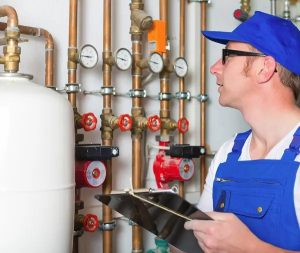Table Of Contents
Checking Your Walls For Leaks
You walk into your home after a long day at work, ready to settle in for the night. You look to your left as you walk towards the kitchen and notice a watermark on your wall that wasn’t there before you left. You start to feel panicked right away. It can cause a lot of damage to sheetrock and floors, and ceilings if a water leak is left undiscovered.
A gradual water leak buried within your home’s walls creates a moist atmosphere that fosters mould and rots wood. Do you know how to identify water leaks in walls and stay on top of repairs around the house? The best method is to hire a professional to inspect the area with a thermal imaging camera and a moisture meter.
When a frozen pipe bursts or a drain backs up, you immediately realise something is wrong. You rapidly locate the source, pinpoint the issue, and do the necessary remedies.
A slow water leak does not draw attention to itself when it begins inside your home’s walls, but it does leave a trail of evidence. You can limit potentially significant damage if you know how to detect water leakage in walls.
Likely Signs Of Water Leaking Inside A Wall
It is quite easy to detect a water leak. Here are six common signs that you have a water leak inside a wall.
- Wet areas on the wall can make it appear as if the wall is sweating. This can be seen upon closer inspection of your walls’ exterior surface, where water is spilling outside of the shower enclosure.
- Mould or mildew has started to grow on the wall if there are black or brown spots on it.
- Your walls’ paint starts to flake and bubble.
- Your wall is damaged, discoloured, and maybe deformed.
- When water sources are cut off, a dripping sound is heard.
- A hot or warm water leak can cause a hot or warm area on your flooring or walls. As you stroll past the walls, you detect the smell of musty odours.
There could be a water leak beneath or in the walls if you’re experiencing any of the following. A sewer scope check might be performed if there is an underground water leak.
What To Do If You Find A Water Leak In A Wall?
- Turn off the main water supply to the house.
- Take a look at your water meter. The water meter is sometimes placed next to the road, and it is here that specialists take the city’s water number each month. This is how you get your monthly water bills.
- Is the water meter still on? If your water meter continues to run after you have turned off your main water supply, you most certainly have a water leak.
Keep an eye out for these 10 symptoms that water is leaking under your drywall.
Musty odours
The flooring and sheetrock become damp and start to smell like wet cardboard as the water drips slowly from a leaking pipe inside the wall. It emits a musty odour that can lead you to the point where there is a leak.
Strange odours may be your only clue about leaks behind the walls because structural materials can absorb water like a sponge.
Mould in weird places
Mould thrives in moist environments such as kitchens, bathrooms, and laundry areas. It’s a good indicator of undetected water leaks whenever it appears on walls or baseboards in other rooms of the house.
Growing stains
Mould can take hold of the inside surface of a wall when it grows in the vicinity of a leaking pipe. A developing stain on otherwise clean sheetrock often indicates a hidden plumbing issue.
Wallpaper or paint peeling or bubbling
This clue is easy to miss in rooms that don’t get much use. Sheetrock that remains damp due to an undetected leak is to blame when you find wallpaper splitting along seams or paint bubbling or peeling off the wall.
Sheetrock warping
Sheetrock draws up moisture from a slow leak over time, and that can cause the wall to flex and twist. Sheetrock that is warped is a sure symptom of a slow water leak.
Stained floors and buckled ceilings
Don’t rule out continual wetness inside the walls if ceilings or flooring in bathrooms, kitchens, or laundry areas develop structural problems. Wet sheetrock may wreak havoc on the structure, flooring, and ceilings around it.
Wet blotches
Wet stains on walls are a sure sign of water damage, but they don’t necessarily indicate where the problem lies. Water can leak down a pipe, resulting in damp blotches on the wall below the leak.
Wet floors
On kitchen floors, this warning is evident, but in carpeted rooms, it is less so. Touch the carpet fibres if a patch of carpeting that is adjacent to a wall appears darker. You most likely have a wall leak if the carpet feels damp.
Dripping sounds
The sound of water dripping down inside walls is common. You’ll normally hear a plinking sound when you turn off a faucet in the sink, tub, or shower. After flushing the toilet, you may hear auditory indications.
Damp window sills
Wet window sills and frames could be a sign of leaky pipes behind the wall. Water from a leak collects on frame edges, sill surfaces, and undersides as it travels downward.
What Causes Water Leaks Inside A Wall?
Pipe leaks can occur in various places, including inside walls, due to faulty plumbing or pipe cracks. Pipes can be damaged regardless of the material used in their construction. Some homes may have Pex plumbing, which rodents can easily damage, and it does not do well in freezing temperatures in colder climates.
In addition, many older homes will have plumbing problems due to galvanised or lead pipes. Polybutylene pipes used in homes between 1978 and 1995 are made of plastic, are inexpensive, and are not very durable. Chlorine also reacts with them, causing leaks at connection points.
Also, consider the possibility that you might have a roof leak. Water can flow downwards from the roof and seep down the wall, causing damage. Even though plumbing problems are to blame in most cases, they are not always the root of the problem.
Hidden Wall Leaks And How To Prevent Them
It’s usually best to leave repairs and remediation to the pros. But there are several precautions you can take to help minimise damage.
Keep gutters clear
Cleaning out the gutters should be the first step in repairing a leaking wall caused by rain. When they’re clogged, torrential rain pours down the outside of your house and seeps into the interior walls.
Check the roof
Water leaking into the walls can signal roof concerns when it rains. Make roof inspections a regular element of your water leakage prevention strategy. Replace any shingles or flashing that are damaged right away.
Examine window weep holes
Water can leak into the walls if the little holes around the bottom margins of storm window frames become clogged. To keep them clean, use a toothpick or a firm toothbrush.
Check washing machine connections
The hose connections between the washing machine and the supply pipes behind the walls deteriorate over time. Regularly check for signs of corrosion and replace any damaged parts as needed.
Inspect your plumbing
Copper and iron plumbing systems rust and leak inside walls. Make plumbing checks part of your regular maintenance schedule. If you live in an older home, this is very crucial.
Change the water pressure
Unnecessarily high-water pressure in your home puts additional strain on pipes and connections. Check the water pressure at a hose spigot several times a year near your home’s main water supply line.
Tests To Determine If There Is A Leak In A Wall
Moisture test
Leak detection is relatively affordable compared to fixing damage already done. A homeowner can stay ahead of such problems by running simple tests like moisture detection. A moisture detection unit is a device that detects moisture in the air.
Moisture detecting equipment is available for purchase at local hardware stores. The gadget will tell you how much moisture there is in your wall. Place the meter against the wall and take measurements in four to five different locations. This information will help you figure out where there is a leak.
Inspection using infrared thermography
An infrared camera is another leak detection method. Using optics, infrared energy, and surface temperature, this camera will employ thermography to analyse moisture in the walls. A company that performs this type of inspection (not all do) will have certified inspectors in this field.
Cut a hole in the drywall
Cutting a hole into the drywall where the leak is visible is one of the last options for leak detection. This will allow you to get behind the wall and see where the probable leak is coming from up close. Remember that this is the last choice because not all leaks are visible from the outside.
Water can travel a long distance before causing damage to a wall. Finally, employing a licensed professional will save you time, money, and costly repairs in the long run.
When Do I Need To Hire A Professional?
You might get home from a long day at work and find a water puddle on the floor or traces of wall damage. These are some instances of things that can easily ruin your day. Wall leakage repair operations can be kept short and manageable by keeping an eye out for hidden leaks.
It also reduces the likelihood of mould growth and vermin infestations beneath your home’s walls. Keep an eye out for the warning indicators we’ve listed above, and be prepared to address them urgently.
Should you have pressing concerns, you should contact a professional plumber or water damage business as soon as you notice any possible damage to your walls or ceiling. Plumbing inspectors can analyse the damage and suggest a more reliable water damage business. This will give you peace of mind because you will get the greatest home repair service for your money.











